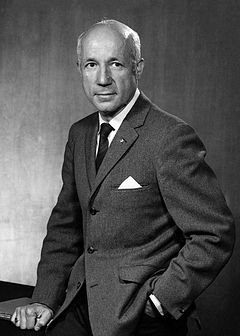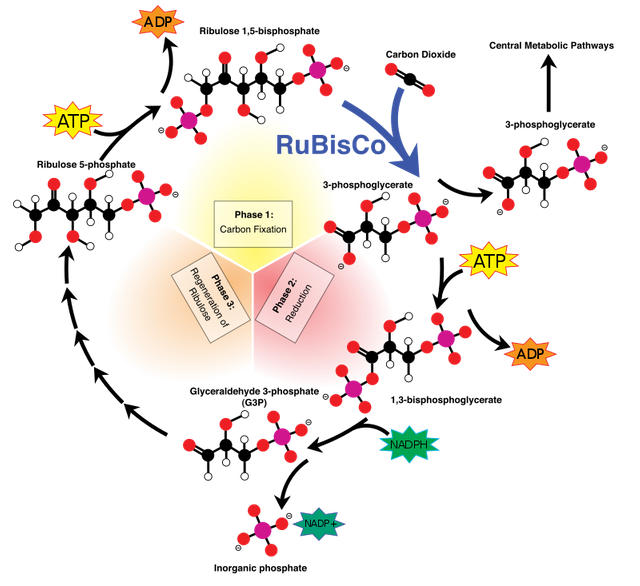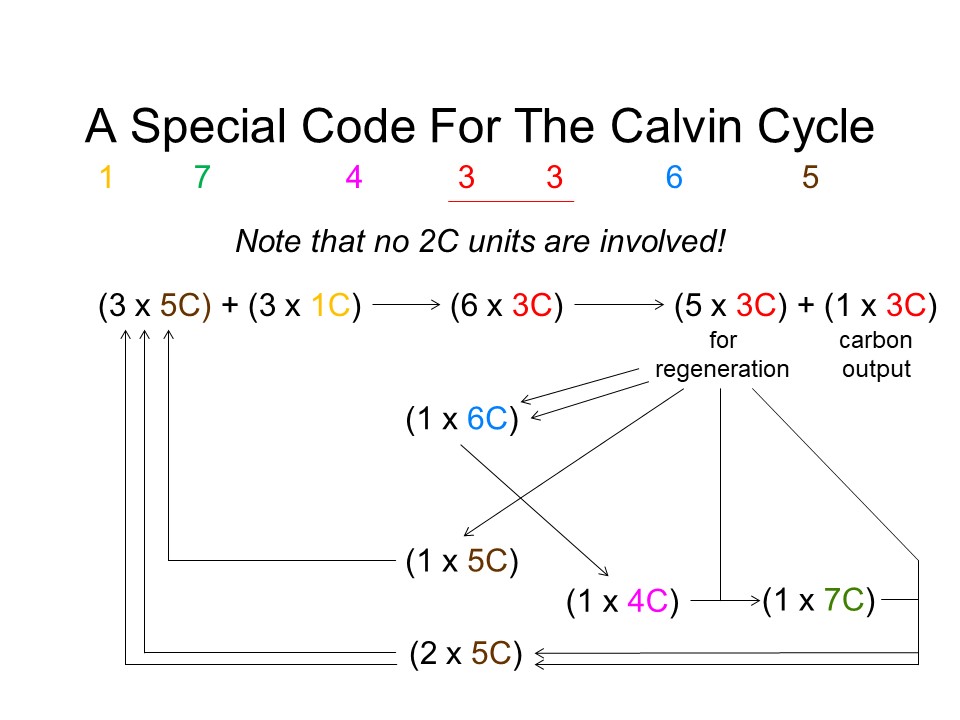The Calvin Cycle of C3 Photosynthesis
The carbon reactions of photosynthesis were discovered by Melvin Calvin and colleagues working with a unicellular green algae. Calvin and colleagues supplied the photosynthetic algae with radioactive carbon-14 labeled carbon dioxide (14CO2) in the light, and took samples at intervals extracting the cells in boiling ethanol. Analyses of the radioactive metabolites formed during 14CO2 fixation by the algae (using two-dimensional thin-layer chromatography (TLC) of the ethanol extracts) revealed that a phosphorylated 3-carbon compound was the first product (hence this process is now known as C3 photosynthesis). Subsequently label was transferred to a large number of other phosphorylated metabolites with 4, 5, 6 and 7 carbon atoms. These metabolites were visualized by exposing the TLC plates to X-ray film. It took several years to identify these compounds and full elucidation of the pathway led to Melvin Calvin being awarded the Nobel Prize in Chemistry in 1961.

Melvin Calvin. Image Source:
I used to joke with my Plant Physiology students that the Beatles (who were just starting their rise to fame playing in the Cavern Club in Liverpool in 1961, the same year that Melvin Calvin won the Nobel Prize) stole Melvin Calvin's wardrobe (suit and black tie), but decided on a completely different hair style!

Beatles (1964). Image Source:
The Calvin cycle is depicted in greatly simplified form in this image from Wikipedia:

Calvin Cycle. Image Source:
Here I need to comment that many texts refer to this cycle as the "Calvin-Benson" cycle, acknowledging the key role of Andrew A. Benson in the early work that led to the elucidation of this pathway (see Benson (2010) and Calvin and Benson (1949) in the references cited below).
The key points about this cycle are:
Ribulose-1,5-bisphosphate (a 5-carbon compound) combines with CO2 (a 1-carbon compound) to produce 2 x 3-carbon compounds (3-phosphoglycerate).
The enzyme catalyzing this reaction is known as ribulose-1,5-bisphosphate carboxylase/oxygenase or RuBisCO. The carboxylase activity of RuBisCO is employed in this reaction. I will discuss the oxygenase activity of this enzyme in a subsequent post on photorespiration. RuBisCO is recognized to be the most abundant protein in the world. In spinach RuBisCO makes up about half the total protein content of the leaf!
This first phase of the Calvin cycle catalyzed by RuBisCO is termed carboxylation or carbon fixation.
The next phase is reduction, in which 3-phosphoglycerate is converted to glyceraldehyde 3-phosphate using ATP and reductant (NADPH) derived from the Light Reactions of Photosynthesis.
In the third phase, glyceraldehyde 3-phosphate is used to regenerate ribulose 1,5-bisphosphate using additional ATP. The key details of this regeneration process are missing from the above image and will be further explained below.
All enzymatic reactions of the Calvin cycle occur in the chloroplast stroma, and have alkaline pH optima, taking advantage of the alkalinization of the stroma that occurs during the Light Reactions of Photosynthesis.
I struggled mightly to explain the Calvin cycle (and in particular the regeneration process) to my undergraduate students in my Plant Physiology course, and came up with the following sentence that captures the essence of the cycle and helped students remember the basic principles:

A Special Code For The Calvin Cycle (D. Rhodes)
Count the number of letters in each word, and each of these numbers corresponds to carbon compounds in the Calvin cycle (1, 7, 4, 3, 3, 6, 5). Note that there are no 2-carbon compounds in the Calvin cycle (however, they do play an important role in the photorespiratory carbon cycle to be discussed in my next article in this series!). The number 3 appears twice, and this should remind us that we have to think in multiples of 3 in order to fully understand the stoichiometry of the cycle.
The first and last numbers from the sentence above (1 and 5) are the first to combine in multiples of 3. From 3 x 1-C compounds (i.e. 3 x CO2 molecules) and 3 x 5-C compounds (i.e. 3 x ribulose-1,5-bisphosphate molecules) we generate 6 x 3-C compounds (i.e. 6 x 3-phosphoglycerates ->-> 6 x 3 glyceraldehyde-3-phosphates).
G3P (glyceraldehyde-3-phosphate) is in equilibrium with DHAP (dihydroxyacetonephosphate) and interconverted by an enzyme called triose-phosphate isomerase. For simplicity these two 3-C compounds are called triose-phosphates.
Five of these 3-C compounds (triose-phosphates) are used for reduction and regeneration, while one can be exported from the chloroplast or used in starch biosynthesis for every 3 CO2 molecules that are fixed (output). I will come back to this point later in the article.
The regeneration phase takes the following steps:
- Two triose-phosphates are combined to give a 6-C compound F16P (fructose-1,6-bisphosphate) which then loses a phosphate group to form F6P (fructose-6-phosphate). 2 x 3 = 6
- This 6-C compound combines with a triose-phosphate to generate a 5-C compound X5P (xylulose-5-phosphate) and a 4-C compound E4P (erythrose-4-phosphate). 6 + 3 = 5 + 4
- X5P is used to regenerate 1 ribulose-1,5-bisphosphate.
- The 4-C compound E4P combines with a triose-phosphate to generate a 7-C compound S17P (sedoheptulose-1,7-bisphosphate) which then loses a phosphate group to form S7P (sedoheptulose-7-phosphate). 4 + 3 = 7
- Finally this 7-C compound combines with the last triose-phosphate to generate 2 x 5-C compounds X5P and R5P (ribulose-5-phosphate) that are again used to regenerate 2 x ribulose-1,5-bisphosphates. 7 + 3 = 2 x 5
- We have accounted for all 6 x 3-C compounds produced (1 exported and 5 recycled), and have regenerated 3 x 5-C compounds as starting material.
For a complete description of these intermediates and the enzymes that produce them, please see the reference (Michelet et al. (2013)) cited below.
A key point here is that all of the intermediates of the Calvin cycle have either 1 or 2 phosphate groups!
As mentioned earlier, a portion of the triose-phosphates generated in the reduction phase of the Calvin cycle can either be exported from the chloroplast to enter into primary/central carbon metabolism, or converted to starch in the chloroplast. The latter requires combining 2 x 3 triose-phosphates to form fructose-1,6-bisphosphate that can then be converted to fructose-1-phosphate and glucose-1-phosphate that serves as the building block for starch biosynthesis.
The export of triose-phosphate from the chloroplast is strictly controlled by the phosphate concentration of the cytoplasm. Thus, triose-phosphate cannot be exported from the chloroplast unless a phosphate is imported from the cytoplasm in exchange via the triose-phosphate/phosphate translocator (a key transport protein on the chloroplast inner membrane that serves as a gate keeper and ensures that the chloroplast is not depleted of phosphate).
The cytoplasmic phosphate concentration is in turn determined by the status of mitochondrial respiration which generates ATP from ADP + phosphate (Pi). When ATP is in short supply in the cytoplasm, Pi levels build, triggering triose-phosphate export from the chloroplast. This supplies carbon skeletons for glycolysis and the citric acid cycle and production of ATP in the mitochondrion. With a "full tank" of ATP (i.e. low free Pi concentration) in the mitochondrion/cytoplasm, export of triose-phosphate from the chloroplast is restricted, triose-phosphate builds up in the chloroplast and is diverted towards glucose-1-phosphate and starch biosynthesis (carbon storage).
Many of the enzymes of the Calvin cycle are redox regulated, and require reduced ferredoxin (produced by photosystem I in the Light Reactions of Photosynthesis) for their activation. Thus, when the light goes on, reduced ferredoxin builds up and the Calvin cycle enzymes are activated by reduction of their sulfhydryl groups via the ferredoxin:thioredoxin system (see Michelet et al. (2013) for further details).
A link to an excellent animation of photosynthesis (including both the light reactions, electron transport and the Calvin cycle) is provided below:
Photosynthesis Light reaction, Calvin cycle, Electron Transport 3D Animation
References
Calvin, M., Benson, A.A. The path of carbon in photosynthesis.IV. Science 109: 140–142 (1949)
Ellis, R.J. The most abundant protein in the world. Trends Biochem. Sci. 4: 241-244 (1979)
Please feel free to leave comments or ask questions below.
Some images in this post are copyright-protected. It is kindly advised that you edit your post and replace them with images under the appropriate license. For more information click on the link below.
https://steemit.com/steemstem/@steemstem/guidelines-on-copyright-standards-in-steemstem
Hi David,
I actually think the first image is copyrighted, if I am not wrong. Maybe could you replace it so that we could support this post (that is great by the way)? Thanks in advance :)
I am very sorry about that, I didn't know it was copyrighted. I have substituted it with one that is public domain from Wikipedia. Please accept my sincere apologies. I will be much more careful about this in the future. Thank you for your support and guidance, I am still a bit of a novice at this.
No problem, we are here to help :)